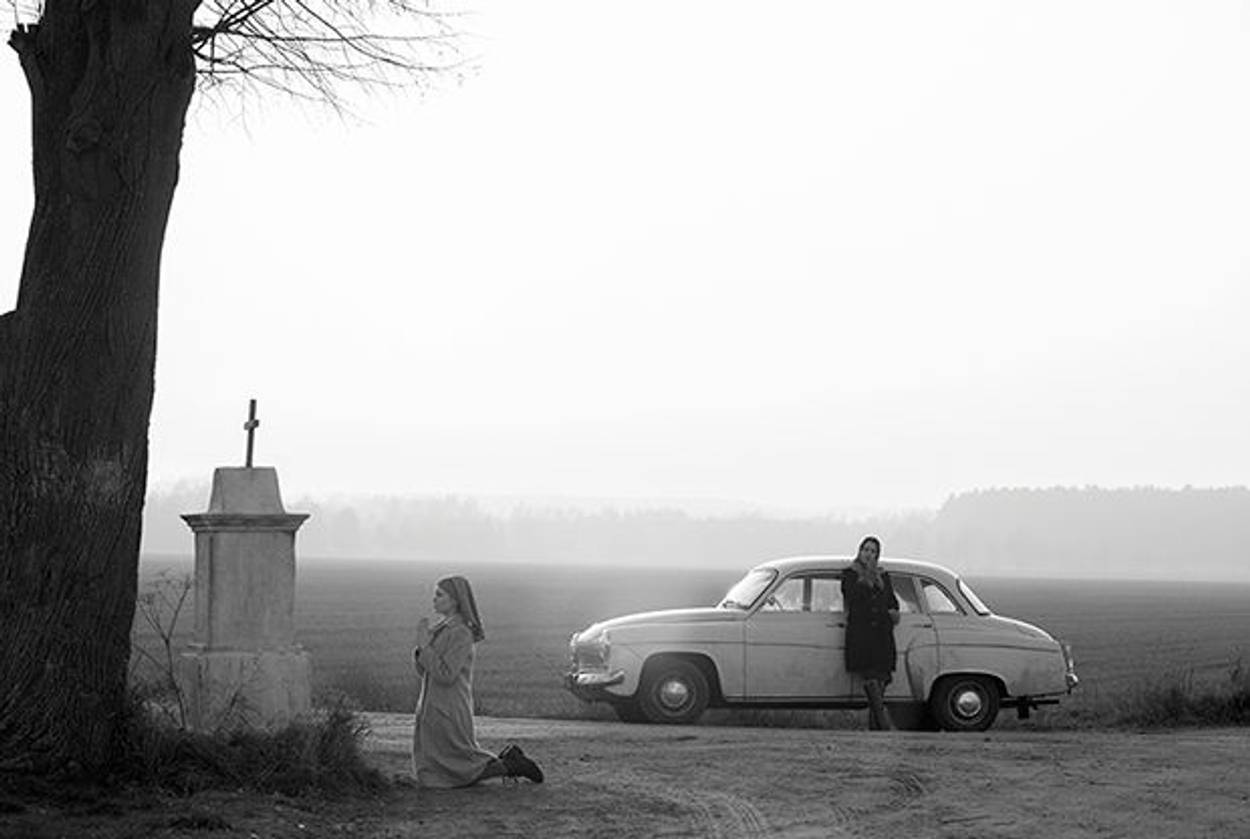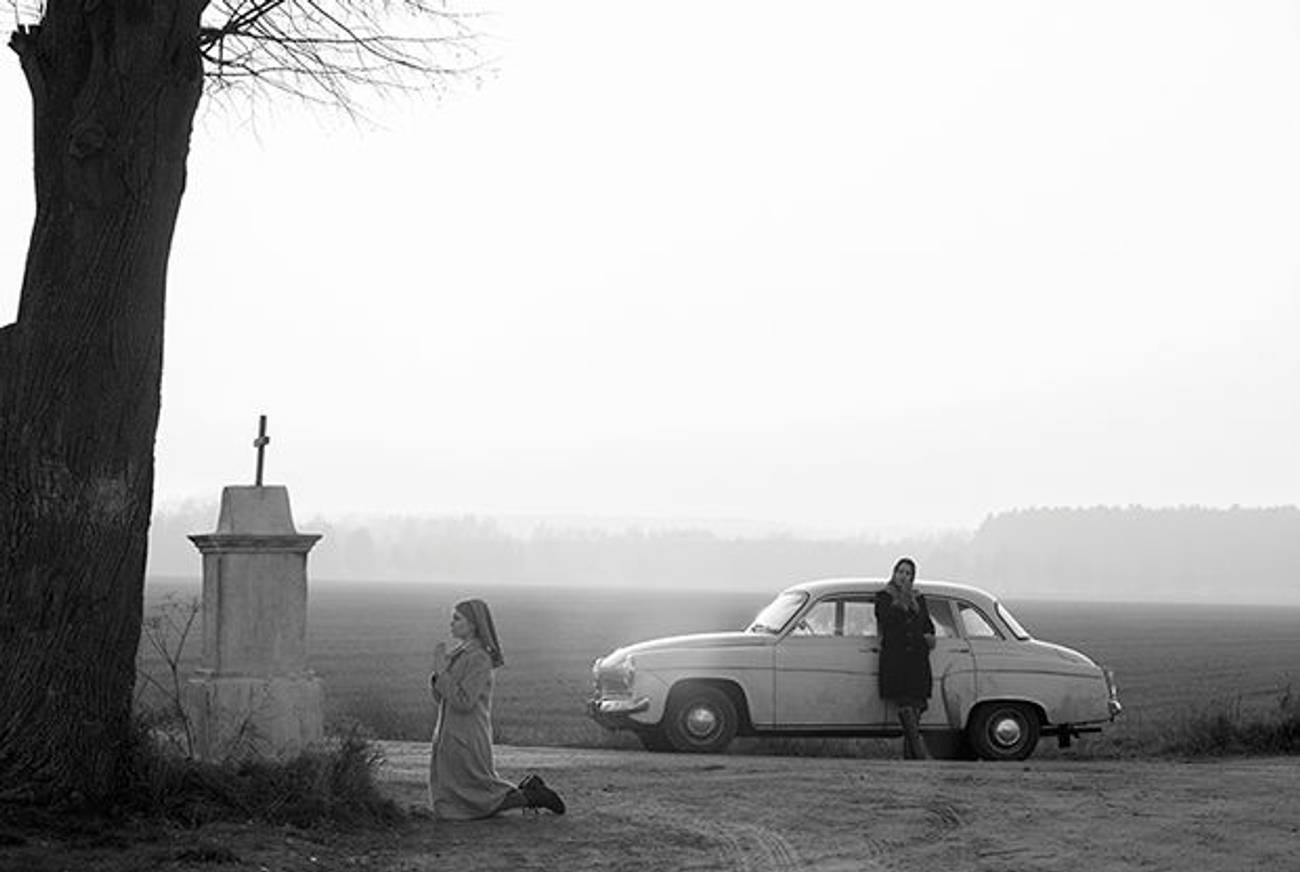‘If You Could Lick My Heart It Would Poison You’
Is Pawel Pawlikowski’s new film ‘Ida’ the Polish answer to ‘Aftermath,’ or a story of Jewish suffering and sacrifice?




“So. You are a Jewish nun,” a cynical Polish Communist greets her teenaged niece with just a touch of sarcasm. Were Ida a more sensationalist work or a 19th-century gothic novel, this bracing, beautifully wrought, and provocative new film, directed by Polish-born, British-trained filmmaker Pawel Pawlikowski from a screenplay co-written with British playwright Rebecca Lenkiewicz, might have taken that characterization for its title.
No spoiler intended: Less than 10 minutes into the movie, which opens in New York on May 2 after amassing festival prizes in Europe and North America and is set in Poland in 1962, Anna—an orphan brought up in a convent and a now novice only a week from taking her vows—discovers who she is, having been sent by the nuns to meet her only living relative, a woman whom she has never seen or even known about. Aunt Wanda (stage actress Agata Kulesza) regards the demure Anna (neophyte Agata Trzebuchowska) with a sort of caustic curiosity even as she bluntly delivers the information that the girl’s birth name is Ida Lebenstein and that her mother (Wanda’s sister) and father were murdered during the war.
Taking this in, the newly de-christened Ida expresses a naïve desire to visit her parents’ graves. With a certain grim satisfaction, Wanda explains that, as murdered Jews, her parents have no marked gravesite; she does, however, offer to take Ida to the village where her family lived and died. A former state prosecutor and current magistrate, Wanda is sufficiently privileged to own a private car and tough enough to confront the peasants she encounters with the crimes they may have committed. Ida is thus a kind of investigatory road film in which, driving through rural Poland, the cloistered novice learns more about life’s cruelties and her country’s recent past than she would surely ever want to know—while her aunt, whose belief in her own secular faith has long since eroded, is forced to re-experience the trauma she would prefer had remained buried.
A child of the Polish intelligentsia, Pawlikowski, 57, has a complicated but not unusual background that includes a Jewish paternal grandmother who died in Auschwitz. His parents sought political asylum in Britain when he was 14 on the pretext of taking a family vacation. “I always felt inhibited talking about Poland,” he said in the course of the public discussion that followed Ida’s screening on the closing night of the New York Jewish Film Festival. “I wanted to do a film about a Poland that doesn’t exist anymore.”
A bracing, beautifully wrought, and provocative new film
First shown in Poland at last October’s Gdynia Film Festival (where it won multiple Golden Lions for best film, best cinematography, and Kulesza’s performance), Ida was thought by some local critics to be an answer or corrective to Władysław Pasikowski’s 2012 Aftermath, a ferocious and polarizing exposé of wartime crimes committed by Poles against their Jewish neighbors. The movies do have some scenes in common. Both feature irate peasants challenged in their muddy, questionably acquired hovels, elderly witnesses questioned in their hospital beds, and awful evidence buried in the verdant Polish woods.
But where Aftermath was something close to a horror film playing out in early-21st-century Poland, Ida is distanced and reflective. Aftermath is designed to bruise, depicting anti-Semitism in the absence of Jews; Ida, which puts its Polish characters face to face with the Jewish “living remnant,” is meant to haunt. It’s one of the film’s ongoing ironies that while Wanda generally inspires fear and loathing, Ida is typically treated with unctuous respect, at least so long as she is wearing her wimple. Small wonder that the novice clings as best she can to her Christian identity.
***
The first dramatic feature Pawlikowski made in his native land, after winning acclaim for his British films, Ida is set in a delicately muted past. It’s a movie less in black and white than shades of gray, not so much a j’accuse as it is a meditation on character and history. Ida is also the story of two women, two religions, two displacements, and two solitudes—subjects that can be found in Pawlikowski’s British features Last Resort (2000), set among the refugees of a British “holding area,” and My Summer of Love (2004), concerning the relationship between two girls of vastly disparate classes, and are at least implicit in his international production The Woman in the Fifth (2011), in which Ethan Hawke plays an American writer confused in Paris.
However formally precise, Pawlikowski’s films are essentially performance-driven. Trzebuchowska, a philosophy student without prior acting experience, projects a stoical innocence. Framed by her headscarf, her soft, unformed features are nothing if not impressionable. Yet it is difficult to read her dark, impassive gaze—the actress is so reserved in her performance as to be nearly a cypher. She is a witness whose thoughts are veiled. Kulesza plays a woman of experience who is hardened by suffering and self-medicated with casual sex and copious alcohol. Her “Red Wanda” may be discomfitingly direct and generally fearless in the face of the mute hostility she encounters, but her inward stare suggests that she judges no one more harshly than herself.
“If you could lick my heart it would poison you,” an aged Polish Jewish partisan tells Claude Lanzmann near the end of Shoah. Wanda might say the same. This embittered, tragic, powerfully portrayed woman struck me as the richest, most sympathetic character in Pawlikowski’s film—although, since she is a victim who not only refused to disappear but lived to wreak vengeance on certain of her countrymen, the nightmarish and decadent personification of what prewar nationalists called Żydokomuna [“Jew” Communism], a Polish audience might not agree.
Ida is not only an evocation of early ’60s Poland, the period of Pawlikowski’s childhood, but a film that gives the illusion that it could have been made then. The hip young saxophonist (David Ogrodnik) that the two women meet on the road isn’t just a disciple of John Coltrane but might have modeled himself after Polish youth star Zbigniew Cybulski. There are echoes of Andrzej Wajda’s Ashes and Diamonds (1958) and Janusz Morgenstern’s Goodbye, Until Tomorrow (1961), both of which starred Cybulski, as well as Jerzy Kawalerowicz’s Mother Joan of the Angels (1961), and although none of these luminously monochromatic movies used the boxy 4:3 aspect ratio that Pawlikowski employs; neither would they have discussed the fate suffered by Jews during the German occupation so vividly or evoked the shabbiness of the Communist regime as straightforwardly.
The movie also conjures, however obliquely, the events of the early ’60s—the cultural thaw that brought the first production of Jerzy Grotowski’s Akropolis and relocation of the annual Jazz Jamboree festival from student digs in Krakow to Warsaw’s Philharmonic Hall, the political infighting that saw the secret lists of Jewish Communists as potential enemies of the state and the mysterious death of Agnieszka Holland’s father Henryk Holland, a reform-minded journalist who, upon being interrogated by state security, jumped or was pushed from a sixth-story window. The early ’60s also marked the first publication (in Polish, in France) of exiled sociologist Aleksander Hertz’s The Jews in Polish Culture, a book that ends its chapter on the image of the Jew in Polish art and literature with the observation that Polish “knowledge of the Jewish world was astonishingly minuscule, fragmentary, and, most frequently, distorted.”
Certainly Ida poses no questions (and neither does Ida answer many). “Will you come to my vows?” the girl asks Wanda at the conclusion of their journey. “No, but I’ll drink to your health,” her aunt tartly replies. The women look at each other, embrace, and go their separate ways—but the film is not quite over. It may be that, having presented Ida an unwanted identity as well as a past she can never assimilate, Wanda sacrifices herself for her niece. But it is a sacrifice that the Jewish nun did not desire, even if it does serve to set her free.
Some have criticized Ida’s open ending. Has the protagonist in any way experienced herself as a Jew? Does she understand what it means to be a Christian? Will she be one of the Carmelite nuns who located their convent in Auschwitz? What lessons, if any, has she taken from her few weeks of living in the world? Pawlikowski’s earliest films were documentaries, and his previous features, notably Last Resort, involved a certain amount of improvisation. Asked if the experience of filming in Poland had changed his conception of Ida, he replied only that his “experience of making a film always impacts on the film.”
There’s a sense in which Pawlikowski is Ida. Implicit in his rapt contemplation of the voluptuously dreary yet transcendent Polish landscape, his movie’s deepest subject is Poland. Ida’s real ending may be that, after many years living and working abroad, the filmmaker has returned and relocated to the land of his fathers and, whether Ida did or not, assumed the burden of a catastrophic history.
J. Hoberman was the longtime Village Voice film critic. He is the author, co-author, or editor of 12 books, including Bridge of Light: Yiddish Film Between Two Worlds and, with Jeffrey Shandler, Entertaining America: Jews, Movies, and Broadcasting.